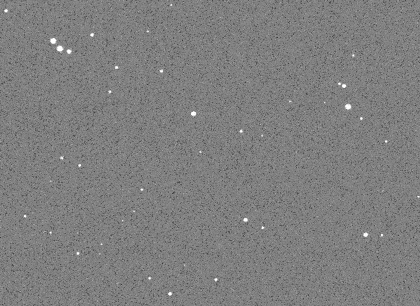 The 4-metre Planck spacecraft on 5th December 2012, when it was 1.5 million km from Earth (© 2012 LT project).
The 4-metre Planck spacecraft on 5th December 2012, when it was 1.5 million km from Earth (© 2012 LT project).
The Liverpool Telescope will be one of a number of observatories around the world to provide support for the upcoming Gaia space telescope. Gaia, a European Space Agency (ESA) mission, will be launched in 2013. Its goal is to generate the largest and most precise 3-dimensional chart of our Milky Way Galaxy. It will do this by measuring the positions of, distances to, and velocities of a billion stars to a precision never before achieved. However, to do the job properly astronomers must know the precise position of Gaia itself. And this is where the LT comes in.
Each night for a period of five years the LT will take a sequence of images of Gaia from its location at the Observatorio del Roque de los Muchachos in the Canary Islands. These images will be immediately transmitted to scientists at the Gaia Ground Based Optical Tracking centre in Heidelberg, Germany. There, the position of the satellite will be accurately measured so that the positions of the stars observed by Gaia can be inferred more precisely.
For two weeks in early December 2012 the LT is taking part in an operations rehearsal. Since Gaia has not yet been launched, to practice its role of satellite spotter, the LT observed another ESA mission instead - the Planck Space Telescope.
Planck was built to map the subtle variations of cosmic background radiation from the whole sky to a degree of accuracy never before achieved, and was the first European mission to study the birth of the universe. The two-ton four-metre spacecraft was launched in 2009 into a similar orbit to the one Gaia will hopefully enter. Incidentally, its flight away from Earth was also captured by the LT; see this archived news story.
The figure accompanying this article shows Planck as it passes across a background of stars. Planck is currently 1.5 million kilometres from earth, at a gravitationally stable location known as L2. L2 is a Lagrange point along an axis that links the Sun to the Earth. Gaia will also observe from L2, and since Planck and Gaia should appear roughly equally as bright in reflected sunlight, observing Planck now is a good way for LT to prepare for its Gaia support duties. L2 is a popular location for space telescopes (the James Web Space Telescope will also observe from L2 when it is launched at the end of this decade). However, because of its considerable distance from Earth, Planck only appears as a spot of light in the LT images. Gaia will likewise be unresolved in the LT observations, though these test images demonstrate that the data will certainly be good enough to pin-point the position of the satellite.
More details about GAIA can be found here: http://sci.esa.int/science-e/www/area/index.cfm?fareaid=26


